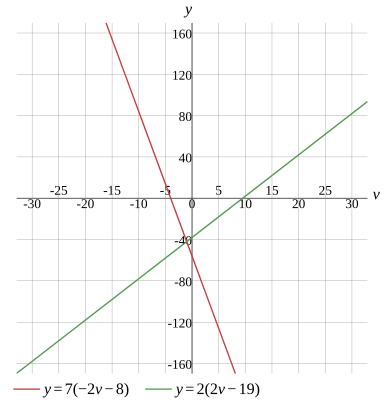Question
Solve the equation
v=−1
Evaluate
7(−2v−8)=2(2v−19)
Calculate
More Steps


Evaluate
7(−2v−8)
Apply the distributive property
7(−2v)−7×8
Multiply the numbers
More Steps


Evaluate
7(−2)
Multiplying or dividing an odd number of negative terms equals a negative
−7×2
Multiply the numbers
−14
−14v−7×8
Multiply the numbers
−14v−56
−14v−56=2(2v−19)
Calculate
More Steps


Evaluate
2(2v−19)
Apply the distributive property
2×2v−2×19
Multiply the numbers
4v−2×19
Multiply the numbers
4v−38
−14v−56=4v−38
Move the expression to the left side
−14v−56−(4v−38)=0
Calculate
More Steps


Add the terms
−14v−56−(4v−38)
If a negative sign or a subtraction symbol appears outside parentheses, remove the parentheses and change the sign of every term within the parentheses
−14v−56−4v+38
Subtract the terms
More Steps


Evaluate
−14v−4v
Collect like terms by calculating the sum or difference of their coefficients
(−14−4)v
Subtract the numbers
−18v
−18v−56+38
Add the numbers
−18v−18
−18v−18=0
Move the constant to the right-hand side and change its sign
−18v=0+18
Removing 0 doesn't change the value,so remove it from the expression
−18v=18
Change the signs on both sides of the equation
18v=−18
Divide both sides
1818v=18−18
Divide the numbers
v=18−18
Solution
More Steps


Evaluate
18−18
Reduce the numbers
1−1
Calculate
−1
v=−1
Show Solution

Graph
